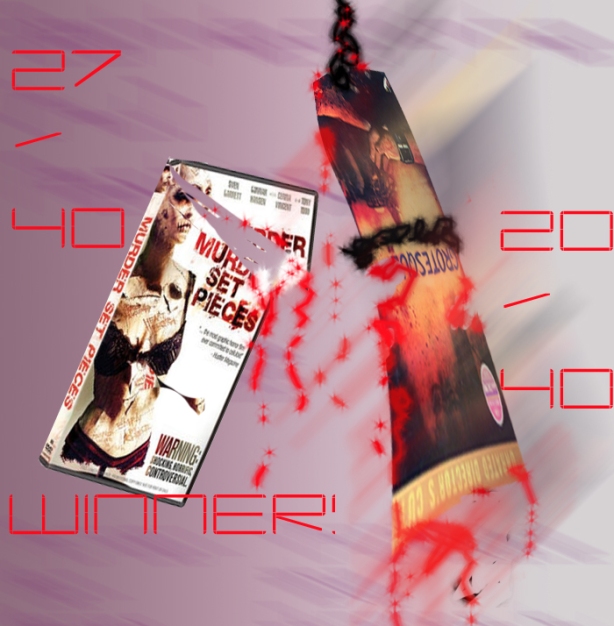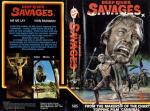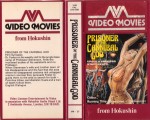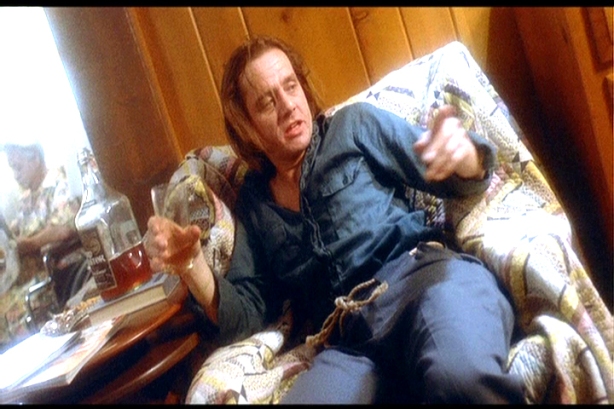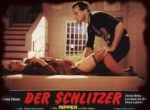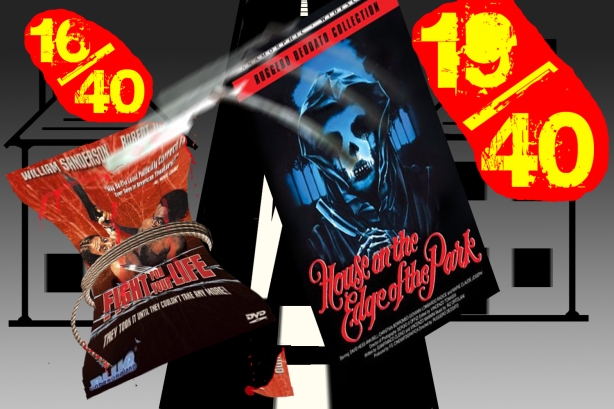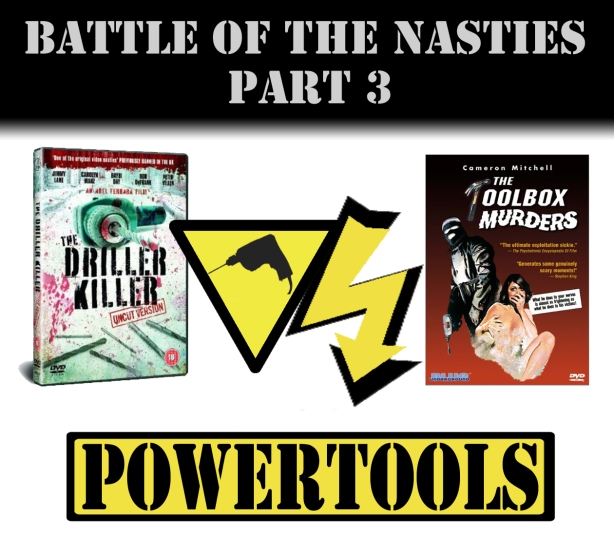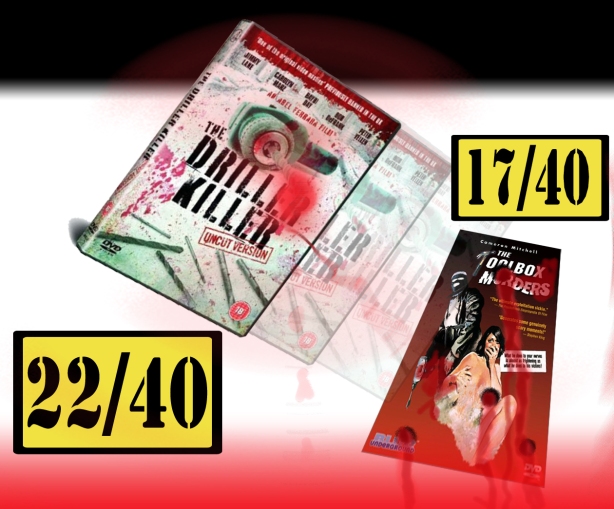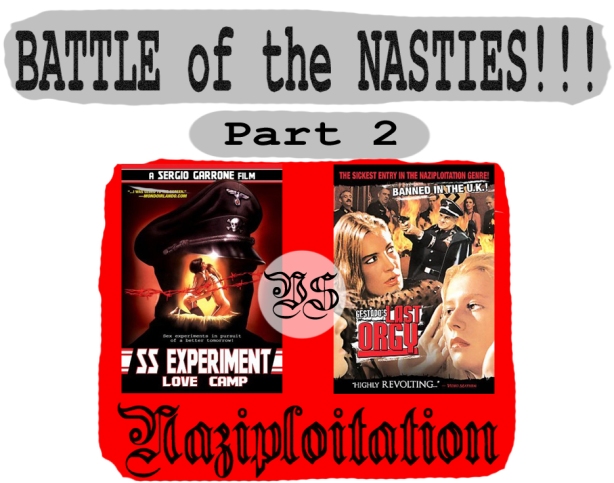26 years after the original video nasty outrage the once banned films are widely available uncut, mostly viewed as a kitsch historical record of what was once found shocking. Pointless controversy is not dead, though, as two obscure horror films have recently been refused certificates by the British Board of Film Classification in an effort to ban their distribution in the UK. Let’s see if they’re any good, then…
Notoriety
Although a ban in the 21st century may be something of an achievement, Googling either film title reveals that any outrage concerns the ban itself rather than the content the films. All news articles are short and evidently the writers don’t consider the subject important enough to watch the films or do any further research. There appear to have been very small outbursts in both the film’s countries of origin, but they seem to be the results of small scale marketing campaigns. Murder Set Pieces’ top claim to fame being several film labs’ refusal to print such a depraved work. 4/10
2009’s Japanese shocker Grotesque distinguishes itself by being the only subtitled horror film to be refused a certificate. Asian horror is normally left fully intact, although Ichi the Killer (2001) notoriously receiving 3m15s of cuts. It has traditionally been the BBFC’s view that the working classes are most likely to be affected by on-screen violence and unlikely to watch foreign language films. Then head James Ferman speaking in 1975 in reference to The Texas Chainsaw Massacre (1972):
“It’s all right for you middle-class cineastes to see this film, but what would happen if a factory worker in Manchester happened to see it?”
BBFC must have thought Grotesque to be so shocking even posh folk what can read wood gettin scarred by that scary forin disk. 5/10
DVD editions
Despite the BBFC ban, the ownership, import or distribution of either film is in no way illegal, but all mainstream retailers follow BBFC guidelines and thus will not to stock uncertified material. The Dutch label Cinema Vault’s uncut edition of Murder Set Pieces is however readily available through eBay or Amazon resellers. The sleeve is rather misleading, as the zombie girl is from a dream sequence, but play the movie and the transfer from 35mm looks tremendous on a big telly, with imposing colour palette as the 5.1 soundtrack thumps, squleches and pierces in involving fashion. The movies’ apparently dubious morals, some production in-fighting and unguarded participants make for a riveting and humorous commentary track. The rare Frightfest edition has a poorer non-anamorphic picture but more extras. Any other editions are heavily censored. 3/5
Grotesque is harder to get hold of, with Malaysian label Keris Video releasing the only English subtitled version of the “unrated directors cut” – the only cut of the film – thus titled in a snipe at the marketing of Hostel (2005). It is possible to wade through the pirate editions to import it through eBay international sellers, but I went for US exploitation specialists Diabolikdvd.com who charge low P&P, accept Paypal and I received my DVD in a couple of days. Customs hassles are possible when importing extreme material, but the worst that can happen is confiscation and I’ve never had any problems at all. The outer box is nicely presented, with an embossed title, but pop the disc in the player and it’s all downhill from there with no extras, low bitrate picture, pixelated subtitles and compressed 2.0 sound. You might wonder why you didn’t save some time and watch it on Torrent instead. 1/5
(note – Diabolik are now selling a different R1 edition, but there are no clues as to its origins or content)
The Films
Murder Set Pieces’ troubled production sees cheap opening credits, with the producers credited under the names of leading Nazis. More questionable taste follows as monochrome 9/11 footage rolls. This could be taken as exploitive or a criticism of the media at the time of filming (2004) when the twin towers were seemingly falling in perpetuity on the current affairs programs. The Nazi theme is ongoing, and could be seen as prejudicial against Germans as the dumb main character reveals himself to be a teutonic Charles Manson quoting, body building, misogynist and serial killer of models and showgirls. Anyone wandering what a young Schwarzenegger might look like slaying sex workers with primary coloured lighting (heavily influenced by Dario Argento’s Suspiria (1977)) need look no further. Known only as The Photographer, when he slips into his native German he sounds suitably oppressive, whereas back in English he gives us such gems as;
“It’s ironic. Women suck blood out of men every day. But at the end of every month it leaks out!”
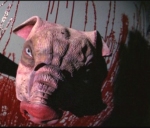
Director Nick Palumbo often uses a pig's mask to signify dehumanisation. Early in the film it is seen waiting in the torture chamber...ready?
Ironic, indeed as a parade of bloody comic book murders play out in the depths of an alternate neon vision of a twisted Las Vegas. The prolonged torture chamber sequences are the films’ most effective as The Photographer seethes and muses in front of his gagged victims and blood stained dolls about the evils of the world. Deft use of editing, and striking flash bulb images cohere the pictures into one powerful vision, and a true updating of the classic slashers of the 70s and early 1980s. Sleaze fans will also be glad to see Leatherface himself Gunnar Hanson play a big fat daughter pimping neo-Nazi gun trader.
Slight trouble in schlock paradise, though, as despite Sven Garrett putting in a genre classic performance in the lead role the other actors are unconvincing non-professionals from the suitably exploitative worlds of adult entertainment and stage school. A couple of poorly executed and irrelevant scenes appear to have been left in for reasons other than for the benefit of the end product. 8/10
Despite a lack of plot being cited by the BBFC as one reason for the ban, Grotesque’s contrite back story is a sweet and simple tale of the meeting of demure young man and woman, contrasted with the torture chamber in which most of the film takes place, as a Lector-esque classical music loving doctor subjects the bashful lovers to “unimaginable” torments, whilst the motif “would you die for me?” is often pondered, reminding one of Bram Stokers Dracula (1992). With most J-horror awash with unnecessary and tedious surreal sequences this is not afraid to nail it off at 72 minutes, and is all the better for it.
Another reason for the BBFC’s exception to the film manifests itself in an eight minute scene of multiple sexual abuses, at the climax of which the severely disabled heterosexual male victim performs the unlikely feet of shooting his jism several metres, after a job at the skilled hand of Dr Evil. The whole scene is more effective than it deserves due to some skilled acting and effective sound, and whilst rather it may be rather trying, some may suspect sick comedy. This view is borne out by the film’s pantomime conclusion. However, I believe the effect to be the result of a lack of focus and care that can be seen in confused mix of laughs, faux snuff and love story, although all the elements are entertaining enough in their own ways. Fans of pain polemics Martyrs (2008) and Audition (1999) may be find much to like, but this is not nearly as satisfying as the high standards set by either. 6/10
Shock and Gore
As modern movies these two in a fair fight against torture porn king The Passion of the Christ (2004). Although neither film can match Mel Gibson’s maniacal 126 minutes of designer flagellation and slow death, Murder Set Pieces has a pretty good pop, with much hyperreal blood flow courtesy of uber-gore specialists Toetag Pictures, who delight in showing us heavily stylised killing of women in and out of the designer lit torture chamber, with nice attention to detail on the blood stained chains and bones. Felatio from a dismembered head traditionally causes problems at the BBFC as well. The graphic child slaying is hard to watch and I find the use of child actors in this kind of material to be misjudged, as these sequences are either unconvincing or distract the viewer into worries for the actual children, although they are always unfounded as is the case here. 8/10
Grotesque’s signature slow burn torture is inspired by ‘80s faux-snuff originating Japanese Guinea Pig series. The doctor’s quest for carnal satisfaction through sadism knows only the bounds of a limited FX budget, and an eagerness for sexual torture that is at odds with an unwillingness to show genitailia, making for a confusing castration sequence. All is helped along by the decent acting during a variety of censor baiting amputations. A superior finger necklace is shown in all stages of construction. 6/10

Battle of the Chainsaws: The calm Dr Grotesque's use the saw as a surgical instrument may be novel, but Sven Garrett's lunatic weilding and a blistering use of sound just pips it for MSP
Soundtrack
Everything sounds as good as it looks with a superb variety of cues from Tangerine Dream inspired ethereal synth chords to neo-retro grinding and ripping reminiscent of old skool slasher scores. A bit of Goblin inspired prog rock even gets a look in. To its utmost credit it retains its own strong identity throughout, mostly down to the recurring reversed and delayed plucking of the eerie signature piece. Murder Set Pieces also features possibly celluloid’s first and last double lesbian strpiier razor slaying set to bangin’ EBM. 4/5
From the inappropriate slapstick tune of opening credits, Grotesque is punctuated by the annoying and dated use of musical irony. Some of the classical pieces are quite pleasant, such as Puccini during the rejuvenation segment, but the synthesised Elgar late in the film is shockingly poor in every possible aspect. The original atmospheres show clichéd but pleasing use of industrial scrapes augmenting terrified yelps of victims, with some reverberating big drum hits, whose simplicity suggest they are direct from sample libraries. A terrible 80s inspired power rock song accompanies the end credits. 1/5
Result
Murder Set Pieces uses its sexy production values to lure Grotesque back to its pad. Bludgeoned, hog tied from the ceiling and abused for weeks, its confused identity finishes it off as its uncaring makers abandon it to its fate. Outside the battle, both films remain obscurities worldwide, thought to be offensive but so little seen outside their target niche that they offend nobody. Aside from the censors at the BBFC, whom it might be possible to take seriously if they concentrated on their real job which is to provide a valuable age classification guide for parents and cinema goers, instead of indulging in ineffectual cuts and bans based upon inconclusive research, and their own sensibilities. Sensibilities which are evidently fragile and easily poked by warped fantastical works that are an escape from, rather than the cause of, the planet’s many actual problems.


